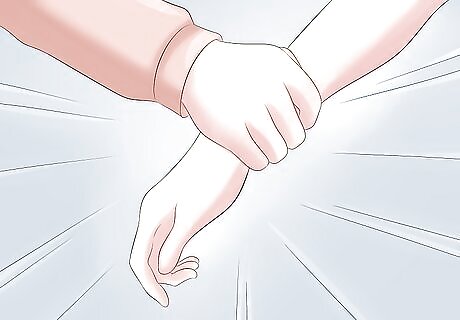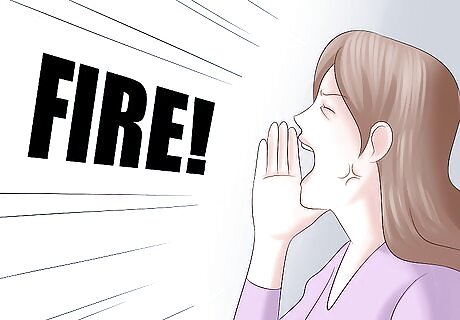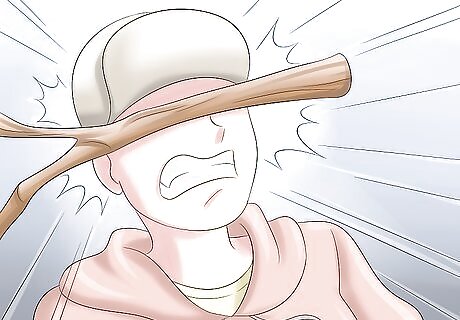
views

Be aware of your surroundings at all times. Whoever you are and wherever you go, it is important to remain alert to your surroundings at all times and to take great care not to end up in an area where trouble in the form of fights, confrontation, and aggression is a high likelihood. For example, keep out of known bad neighborhoods if at all possible; when traveling, ask the locals where the safe parts of the city, town, or country are and stay in those.

Recognize when a confrontational situation is imminent. Obviously, if someone is about to punch you as you reach them, you're more than aware that you're in a confrontational situation. However, recognizing earlier signs can make it easier for you to know when to do something about it and to get away faster. In fact, psychologists have shown that not only do we tend to sense trouble as it's looming toward us but that in 99 percent of cases, people give off signs and warnings as to what they're about to do. It is at the moment of spotting these signs that you still have a chance to get away. Look for such signs as: Aggressive stances of the potential attacker and any other people standing around Aggressive, abusive, and unfriendly language being shouted out Threats being made to you and others The brandishing of weapons, whether obviously a weapon, or a makeshift weapon such as pieces of wood, cut glass, broken items that have been sharpened etc. Menacing gestures and attitudes Your inner gut feeling tells you that you're getting into a bad situation; sense it and listen to your senses.

Exit the situation as soon as you can prior to physical contact. If you can quickly turn off down a street or double back swiftly before you even reach the aggressor, do so. You may not need to run or you may consider that running might attract undue attention at this stage; you'll need to assess that according to the situation. Judge it swiftly and simply get out of there. At this stage, you may not be pursued, so count yourself lucky if so and learn a lesson from the situation. Avoid making eye contact with any aggressor. Doing so can be enough to provoke an attack. Equally, say nothing at all to the aggressor; give the aggressor the space needed to chill on focusing on you as a target. By leaving before a confrontation even ensues, you may "outrun" your attacker by deflating their opportunity and not have to run that far at all; just around the corner and out of sight. Be aware that many of us are media-primed to think we need to "stand and fight". That is not only a baseless assumption (after all, movie fight scenes take months to choreograph, film and edit!) but doing so will potentially endanger your life. Peculiar notions of bravery and nobility can blind you to danger.

Know that you are able to run. While this may sound self-evident when reading it, when in the midst of a confrontation, it might not be as obvious. For instance, are you wearing clothes you can run in comfortably, or are you in high heels and a pencil skirt? You might have to toss the shoes, rip the skirt, and run barefoot in the latter case! In addition, know your fitness limitations. If you're in generally good shape, a brief run should be fine but it'll start hurting the longer you run. If you're in very poor shape physically, even the brief run will possibly be too strenuous and you may fall over, collapse, or simply not be able to run at all. Obviously, it's too late to wish you'd kept in good shape when the incident happens, but since you're reading this, do consider staying in shape as one good way of keeping yourself safe. If you are not able to run at all, you're going to have to use other self-defense mechanisms to escape, such as walking away fast, not provoking the situation, hiding as soon as possible, or deflecting blows and protecting your vulnerable organs if the worst happens.

If you're put into the situation where you have been physically caught up with an aggressor or you've walked into an aggressive situation and you're surrounded, you'll need to find the moment when you can run away. Expend much of your energies looking for any single moment that will allow you to get away from your attacker or aggressor and give you the space to begin running. Don't wait to see how the situation will evolve. It is probably going to evolve in a direction that won't be beneficial for you, so presume the worse and get running as soon as you can.

Run to escape your attacker. Whether or not your attacker pursues you is not the point initially; simply presume that you need to put as much distance between you and the attacker as your best safety tactic. While an opportunistic mugger or a territorial fight picker might not have the slightest desire to pursue you after you've left the scene, other reasons such as an angry ex-lover, drugs, gang reputation, hate crime or sheer vindictiveness may spur the person to pursue you; don't presume their motives, just presume you need to escape. As you're running, bear the following in mind: Run fast initially to place distance between you and the attacker. However, after an initial burst, you need to both assess the commitment of the pursuer (are they following or not?) and then to pace yourself and run without exerting yourself. If this person is insistent on pursuing you and you have no energy at all left should they catch you, you won't be able to protect yourself. Pacing yourself is especially important if there is a long way to safety or if you have to throw your attacker off the scent should they pursue you. Aim to run where it is easy to do so and where you won't meet dead ends, high drops, or find yourself cornered. If you don't know the terrain that way, keep a good eye ahead on where you're going. If you can see your attacker beginning to lag, give your running a good burst of speed to seal the distance between you, then return to your pace. By this stage you may be able to lose them through their own lack of endurance. Keep a clear head. You will need to keep thinking and not just let your legs be the solution to your problem. Eventually they are going to get tired and your adrenaline will run down and leave you very tired. Try to keep your wits about you, thinking ahead to how you can throw off a pursuer if need be. Ignore any cries of "Coward!" or "Come back here!". You are doing the right thing by leaving as fast as you're able.

Find ways to throw off any pursuing attacker. As well as running, it is important to back up your distance-creation with other tactics to keep yourself safe. The following are all good options, and probably the more you can put into the action, the better: Make noise. Try to attract attention by yelling out "Help me!" and other phrases designed to draw the attention of others to your plight. A great option is to yell, "FIRE!" People who don't want to get involved in a personal situation may turn their backs on "HELP" but most will be curious and come to see where the fire is located. More people mean more help. If you are in an urban environment, look for a safe place, for example, busy business premises, a police or fire station, hospital, etc. If you are in the woods, run downhill or downstream. If there is a hiding space such as a rock under-hanging, or a cave, you might consider using these to recover and to use your cell phone if you have it with you. However, be conscious that if you can find a hiding place while running, so can your pursuer if they've been watching your flight and haven't lost sight of you; also be aware that they may know the terrain better than you. Look for ways to make following you difficult. Run into a group of people, create obstacles for your pursuers, such as running into a group of people or a building with multiple floors, dashing through traffic (dangerous!) or through a market with lots of stalls, etc. Any time you're around people, scream your head off for help and to scare off the pursuers. Run to bright areas. An attacker is a lot less likely to follow you into well-lit areas where they'll be easier to see and recognized by not only you but by others as well.

Look for ways to increase distance. For example, if you see a fence with a small opening, go through it and continue running. This may slow down your pursuers enough for them to lose sight of you. Losing sight of you is the crucial element to a successful running away. Once you've disappeared, you can find a hiding spot and remain extremely quiet there for some time until you are sure that they have given up both chasing and hunting around for you.

Don't assume that your pursuers have stopped chasing you. If your pursuers are intent on catching you, they may wait for you. Call the police and make a report, even if you manage to make it home and think it's all over with.

Be realistic. There may be a case where you have a persistent pursuer who is gaining on you and you're going to have to stand and defend yourself instead of continuing to run. While running should always be your first line of defense, exhausting yourself won't help you. And one last but very important note: every situation is different and while this article has tried to cover a range of possibilities, the situation you find yourself will be unique and you'll need to judge it quickly according to what you see and drawing on your experience and inner strength. Read How to avoid a street fight and How to defend yourself in an extreme street fight for more information on ways to defend yourself should your escape strategy fail initially. Don't give up though; keep believing you can get away and remain focused on getting away while protecting yourself as best you can.

If possible, throw anything at the attacker or anything that can get in his way. Example: If you are in the woods, throw a heavy, large branch at his face. This might slow him down and give you time to outrun him.




















Comments
0 comment